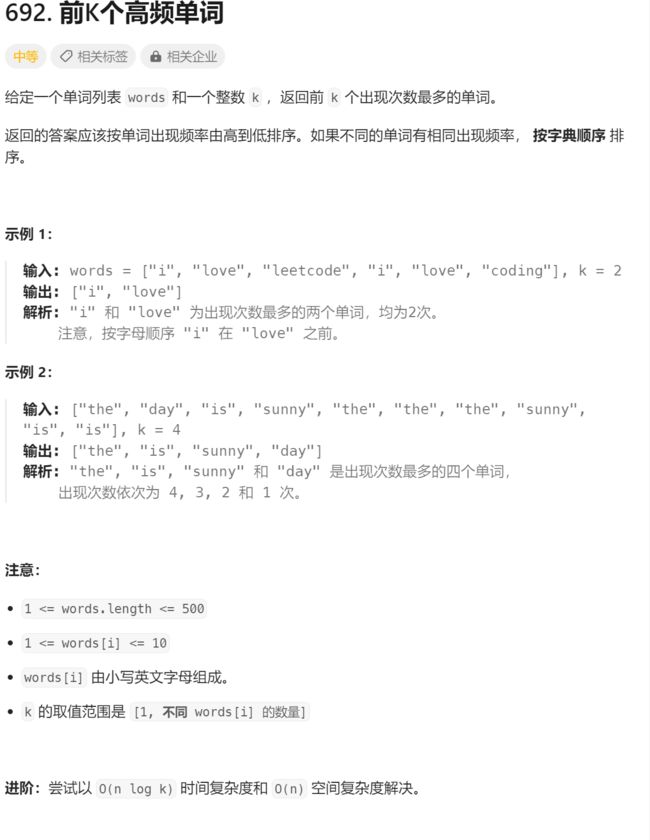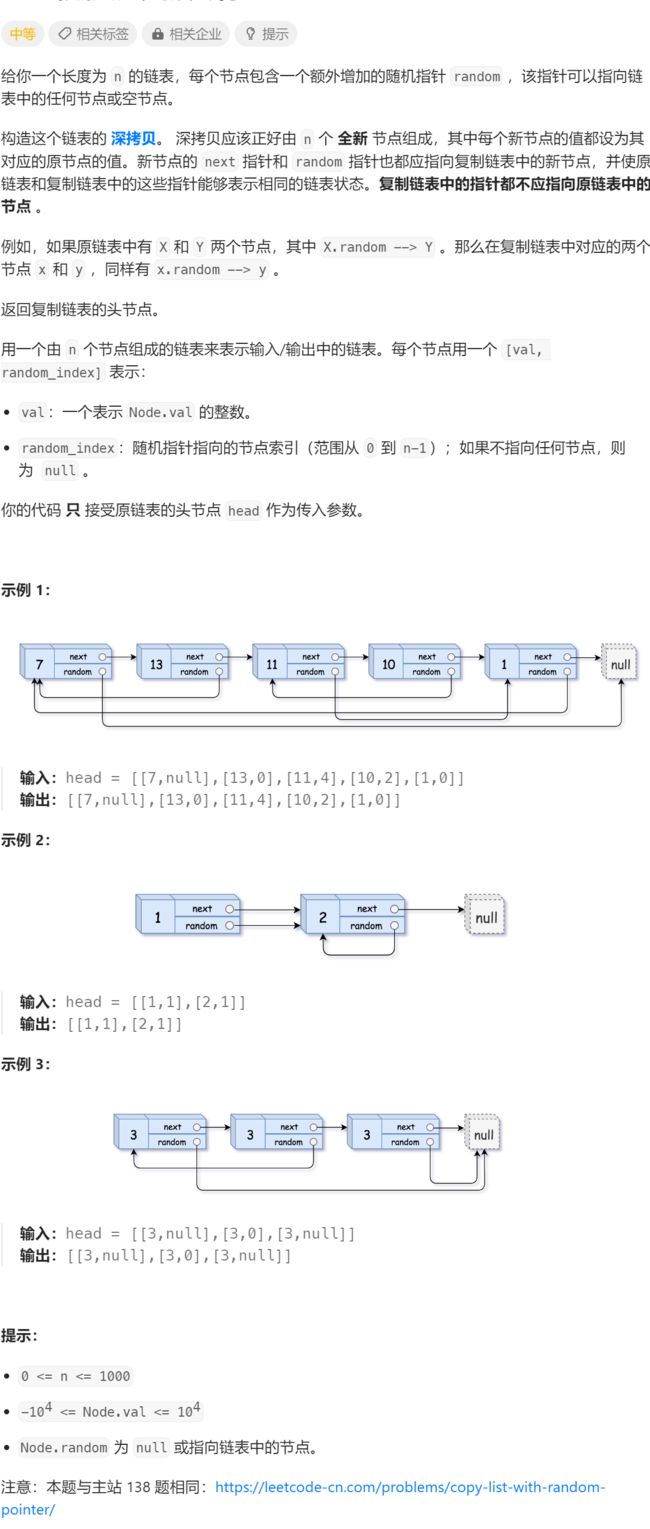set和map的学习
文章目录
- 1.set的原型
- 2.set的成员函数
-
- 1.构造函数
- 2.代码演示
- 3.map的原型
- 4.map的成员函数
-
- 1.构造函数
- 2.代码演示
- 5.OJ练习
-
- 1.前K个高频单词
- 2.两个数组的交集
- 3.随即链表的复制

1.set的原型
template <
class T, //set::key_type
class Compare = less<T>, //set::key_compare
class Alloc = allocator<T> //set::allocator_type
>
class set;
2.set的成员函数
1.构造函数
//全缺省构造
explicit set(const key_compare& comp = key_compare(), const allocator_type& alloc = allocator_type());
//迭代器区间构造
template <class InputIterator>
set(InputIterator first, InputIterator last, const key_compare& comp = key_compare(), const allocator_type& alloc = allocator_type());
//拷贝构造
set(const set& x);
2.代码演示
//插入、迭代器、范围for
void test_set1()
{
//初始化1.0
set<int> s;
s.insert(3);
s.insert(1);
s.insert(4);
s.insert(2);
s.insert(1);
s.insert(2);
//初始化2.0
//set s = { 1,2,1 };
//set s = { 1,2,1 }; //显式传compare
//初始化3.0
//int a[] = { 1,2,1 };
//set s(a, a + sizeof(a) / sizeof(int));
set<int>::iterator it = s.begin();
while (it != s.end())
{
// 二叉搜索树不允许修改key--破坏二叉搜索树的原则
cout << *it << " ";
++it;
}
cout << endl;
// 范围for
for (auto e : s)
{
cout << e << " ";
}
cout << endl;
//set遍历后数据变成有序的 -- 搜索二叉树中序遍历 -- 有序数据
}
//erase 查找是否存在:find/count 删除某个范围的值
void test_set2()
{
set<int> s;
s.insert(3);
s.insert(1);
s.insert(4);
s.insert(2);
s.insert(1);
s.insert(2);
s.erase(30);
//erase的底层
auto pos = s.find(30);
if (pos != s.end())
{
s.erase(pos);
}
int x;
while (cin >> x)
{
/*
auto ret = s.find(x);
if (ret != s.end())
{
cout << "yes" << endl;
}
else
{
cout << "no" << endl;
}
*/
//count在set里的取值: 1 0
if (s.count(x))
{
cout << "yes" << endl;
}
else
{
cout << "no" << endl;
}
}
set<int> s1;
set<int>::iterator itlow, itup;
for (int i = 1; i < 10; i++)
s1.insert(i * 10); //10 20 30 40 50 60 70 80 90
itlow = s1.lower_bound(25); //记录25或25后一个元素
itup = s1.upper_bound(60); //记录55后一个元素的位置
s1.erase(itlow, itup); //[ , )
cout << "s1 contains:";
for (auto it = s1.begin(); it != s1.end(); ++it)
cout << ' ' << *it;
cout << '\n';
}
//多重set:multiset 允许键值冗余[重复]
void test_set3()
{
multiset<int> ms;
ms.insert(3);
ms.insert(1);
ms.insert(4);
ms.insert(2);
ms.insert(1);
ms.insert(1);
ms.insert(1);
ms.insert(2);
multiset<int>::iterator mit = ms.begin();
while (mit != ms.end())
{
cout << *mit << " ";
++mit;
}
cout << endl;
//中序遍历的第一个x
auto pos = ms.find(1);
while (pos != ms.end() && *pos == 1)
{
cout << *pos << " ";
++pos;
}
cout << endl;
cout << "1的个数" << ms.count(1) << endl;
ms.erase(1); //删除所有的1
cout << "1的个数" << ms.count(1) << endl;
cout << "2的个数" << ms.count(2) << endl;
//删除第1个3
auto pos = ms.find(3);
if (pos != ms.end())
{
ms.erase(pos);
}
//删除第2个3
++pos;
if (pos != ms.end())
{
ms.erase(pos);
}
}
3.map的原型
template <
class Key, // key_type
class T, // mapped_type
class Compare = less<Key>, //key_compare
class Alloc = allocator<pair<const Key,T> > // allocator_type
>
class map;
4.map的成员函数
1.构造函数
//全缺省默认构造
explicit map(const key_compare& comp = key_compare(), const allocator_type& alloc = allocator_type());
//迭代器区间构造
template <class InputIterator>
map(InputIterator first, InputIterator last, const key_compare& comp = key_compare(), const allocator_type& alloc = allocator_type());
//拷贝构造
map(const map& x);
2.代码演示
/*
template
struct pair
{
T1 _key;
T2 _value;
pair()
: _key(T1())
, _value(T2())
{
}
pair(const T1& a, const T2& b)
: _key(a)
, _value(b)
{
}
};
*/
/*
template
inline pair make_pair (Tl x, T2 y)
{
return ( pair(x, y) );
}
*/
//插入、迭代器、make_pair
void test_map1()
{
map<string, string> m;
//创建pair -- 传参
pair<string, string> p("Kevin", "凯文");
m.insert(p);
//匿名对象
m.insert(pair<string, string>("Kevin", "凯文"));
//make_pair
m.insert(make_pair("Eddie", "彭于晏"));
m.insert(make_pair("Tom", "汤姆"));
m.insert(make_pair("Jerry", "杰瑞"));
//map::iterator
auto it = m.begin();
while (it != m.end())
{
//cout << (*it).first << "-" << (*it).second << endl;
cout << it->first << "-" << it->second << endl;
++it;
}
cout << endl;
for (const auto& e : m)
{
cout << e.first << "-" << e.second << endl;
}
cout << endl;
}
//count的功能[初识at]
/*
pair(const T1& a, const T2& b)
: _key(a)
, _value(b)
{
}
1.查找
查找key是否存在
存在返回value的引用
不存在插入 pair( key, V() ) 返回value的引用
2.查找 + 修改
查找key 存在 返回value的引用 将其赋值成新值--修改
3.查找 + 插入
查找key 不存在 插入key 分配value 返回value引用
*/
/*
V& at(const K& key);
查找key是否存在
存在返回value的引用
不存在抛异常
*/
void test_map2()
{
map<string, string> m;
m.insert(make_pair("Eddie", "彭于晏"));
m.insert(make_pair("Tom", "汤姆"));
m.insert(make_pair("Jerry", "杰瑞"));
//m.insert(make_pair("Eddie", "(彭于晏)")); // 插入失败:已经有了string:key不能重复
m["abc"]; // 查找+插入: m中没有abc 插入abc并调用默认构造为其分配一个映射值即value 返回value的引用
m["ABC"] = "牛顿"; // 查找+插入+赋值: m中没有ABC 插入ABC并调用默认构造为其分配一个映射值即value 返回value的引用 将value赋值为"牛顿"
m["Eddie"] = "埃迪"; // 查找+修改: m中有Eddie 返回与其匹配的value的引用 将其修改为埃迪
cout << m["string"] << endl; // 查找输出string对应的value值
}
//统计玩具次数
void test_map3()
{
string s[] = { "陀螺", "陀螺", "洋娃娃", "陀螺", "洋娃娃", "洋娃娃", "陀螺",
"洋娃娃", "悠悠球", "洋娃娃", "悠悠球", "乐高" };
//法一:
//map count;
// for (auto& key : s)
//{
// auto pos = count.find(key);
// if (pos == count.end()) //没找到 map里没有此元素 插入
// {
// count.insert(make_pair(key, 1));
// }
// else
// {
// pos->second++;
// }
//}
//法二:
map<string, int> count;
for (auto& key : s)
{
/*
template
class map
{
K _key;
V _value;
};
template
struct pair
{
T1 first;
T2 second;
pair()
: first(T1())
, second(T2())
{
}
pair(const T1& a, const T2& b)
: first(a)
, second(b)
{
}
};
insert函数调用
pair insert(const pair& p);
iterator insert(iterator pos, const pair& p); //在pos处 插入一个键值对 返回pos迭代器
template
void insert(InputIterator first, InputIterator last); //迭代器区间构造 返回值为void
V& operator[](const K& key)
{
pair it = insert( make_pair( key, V() ) );
//插入一个键值对 返回键值对类型
return it.first->second; //返回value的引用
//it是一个键值对类型
//it.first: 访问类pair的first成员变量 在此pair里first类型为iterator 即it.first为指向key的迭代器[结构体指针类型]
//访问value: (*it.first).second == it.first->second
}
*/
//key不在count 插入pair( key, int() ) iterator指向key bool-true
//key在count iterator指向原有key bool-false
count[key]++;
}
for (auto& toy : count)
{
cout << toy.first << ":" << toy.second << endl;
}
}


